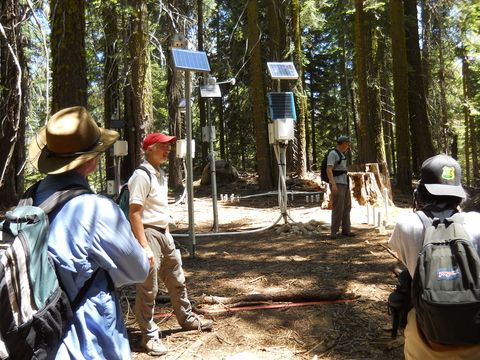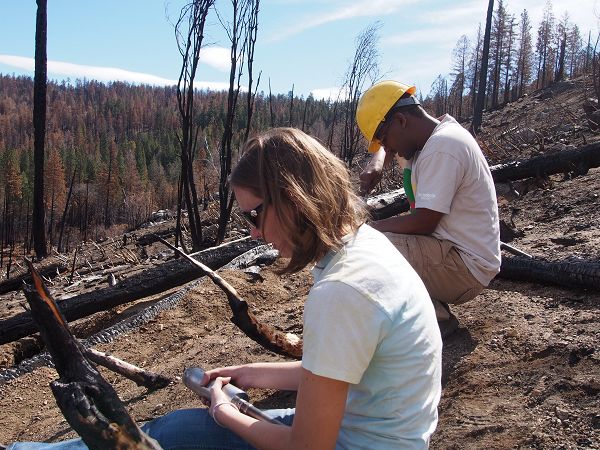All Hands Meeting
PRESENTATION/TALK | MEETING/CONFERENCE
2014 All Hands Meeting for the CZO Network
Tenaya Lodge, Fish Camp, California
This page will be updated with the agenda and other events for the 2014 All-Hands Meeting in California. The agenda below is current as of August 12, 2014. See the attached document for more details.
Full details on travel, lodging and other logistics will be communicated through the news page.
**RECENTLY UPDATED** FINAL AGENDA posted (9/17), slight agenda adjustments, Field trips modified.
Topics for breakout groups are invited. The working list is current. Send your suggestions to Dr. Roger Bales!
Arrival Day - Sunday, September 21
Buses from Fresno will be scheduled to accommodate travel
4:00 - 7:00 Registration; Informal discussions, sign up for field trips, post posters
6:00 - 8:00 Dinner (rolling buffet, eat at your convenience)
7:00 - 9:00 Overview posters (more information coming soon)
Day 1 - Monday, September 22
8:00 - 8:40 Introduction to meeting: welcome, meeting aims, quick introductions
8:40 - 9:25 Integrative keynote talk on CZ science - Mike Goulden, Southern Sierra CZO
9:25 - 9:45 Charge to participant, introduction to themes
9:45 - 10:15 International CZO discussion & report from meeting in China - Zhu, Banwart, Silver
10:15 - 10:45 Break & poster viewing
10:45 - 12:15 Theme 1 - What controls CZ properties and processes?
12:15 - 1:30 Lunch, with a talk on Ecosystem Services
1:30 - 3:00 Theme 2 ̶ What is response of CZ structure, stores, and fluxes to climate?
3:00 - 3:30 Break & poster viewing
3:30 - 5:00 Theme 3 ̶ What is response of CZ structure, stores and fluxes to land use change?
5:10 - 6:30 Breakout groups on Themes 1-4 (organization meetings before dinner)
6:30 - 7:30 Dinner
7:30 - 9:30 Poster viewing, additional time for breakout groups
Day 2 - Tuesday, September 23
8:00 - 5:00 Field Trips, with bag lunches
Trip 1 (45 spots) Rim Fire & post-fire landscape mosaic in Yosemite
Rim Fire, Cherry Lake, Hetch Hetchy Reservoir, and Crane Flat Lookout (J. Roche, L. Sullivan, M. Conklin)
Trip 2 (120 spots) New advances in the long-studied elevational transect of the western Sierra Nevada
Stop 1: Drought-dust interactions; soil evolution at the catena level (E. Aronson, T. O'Geen)
Stop 2: Vegetation-atmosphere interactions, Providence Catchment (Lucas, Hartsough, Goulden, Stacy, Bales)
Stop 3: Bedrock, vegetation and landscape evolution, Bald Mountain (C. Riebe, W.J. Hahm)
6:30 - 7:30 Dinner with a local presenter (natural history / management talk)
7:30 - 9:00 Optional: continuation of theme breakout discussions or alternate groups
Day 3 - Wednesday, September 24
7:00 - 8:00 Breakfast; meeting for Steering Committee with NSF officers
8:00 - 9:30 Theme 4 ̶ How can CZ understanding be used to enhance resilience and sustainability, and restore ecosystem function?
9:30 - 11:00 Breakout groups - Additional work time
11:00 - 12:00 Breakout groups - Wrap up discussions of next steps and develop summary document
12:00 - 2:30 Lunch, reports from breakout groups
2:30 - 3:30 Steering committee report to CZO All Hands meeting group
3:30 - 3:45 Meeting wrap-up, comments
3:45 First bus to Fresno airport / hotels
3:45 - 4:30 Follow-up breakout meetings
- CZO PI discussion
- Time to work on products or outline papers
4:45 Last bus to Fresno airport/hotel
Theme details
Theme 1 - What controls CZ properties and processes?
a. How does critical zone development depend on lithology and geologic legacy?
b. How does critical zone development vary with climate?
c. How does biota influence critical zone development?
d. How does hillslope aspect, as it influences local climate, affect critical zone evolution and structure?
Theme 2 ̶ What is response of CZ structure, stores, and fluxes to climate?
a. What is the relationship between concentration & discharge?
b. What factors moderate soil-organic carbon relationships in shallow and deep soil?
c. How do material & energy fluxes across boundaries relate to climate?
d. Especially on shorter time scales, what controls biogeochemical stores and fluxes within the CZ?
e. How do microbial communities (activity, composition) influence biogeochemical stores and fluxes?
Theme 3 ̶ What is response of CZ structure, stores and fluxes to land use change?
a. How does the CZ respond to climate change & land-use/management effects?
b. How does regolith affect vegetation?
c. How do (bi-directional) vegetation-regolith dynamics influence CZ structure, stores & fluxes, including water & C?
d. How do material and energy fluxes across boundaries relate to land use change?
Theme 4 ̶ How can CZ understanding be used to enhance resilience and sustainability, and restore ecosystem function?
How can we apply understanding of the Critical Zone to enhance ecosystem services and patterns such as:
water resources, disturbance, ecological indicators, sustainability?
Breakout Groups - working list
Topics for breakout groups are invited! Please contact Erin or session conveners. Updated August 20.
1. CZTope
2. Field Managers
3. Organic Matter
4. Indexing methodologies to support common measurements
5. Establishing an International Visiting Scholars Network
6. T2a - What is the relationship between concentration & discharge?
7. T2 b - What factors moderate soil-organic carbon relationships in shallow and deep soil?
8. T2c - How do material & energy fluxes across boundaries relate to climate?
9. T2d - Especially on shorter time scales, what controls biogeochemical stores and fluxes within the CZ?
10. T2e - How do microbial communities (activity, composition) influence biogeochemical stores and fluxes?
Introductory Posters
These posters will be posted on Sunday afternoon and evening, and pending space, through the rest of the conference. The posters will not be the regular research posters, but more like a map or infographic foldout from National Geographic. Each CZO is encouraged to bring 2-3 posters, choosing from the following 3 topics.
(1) Wayfinding (maps, conceptual model) (2) Gadgets & Installations (3) CZTope
These posters should be heavy on maps, figures, conceptual structures, and pictures. What is the bigger picture? The goal is to orient colleagues from across the network to your CZO site, locations and ecosystems, though they may never have visited the area. Please see the poster call (to be uploaded soon) for examples.
Please note: The Organic Matter Working Group has chosen to present a cohesive poster presentation as a whole. We are coordinating with them to organize across all of the CZO locations.
One field trip will include stops at the San Joaquin Experimental Range, the SSCZO Providence Catchment with the Critical Zone Tree-1 and the P301 eddy covariance flux tower. Other stops will include Bald Mountain, future NEON sites, and roadside cuts to explore saprolite profiles.
The other trip will head north into Yosemite National Park and beyond to expore the effects of the Rim Fire and other fires. UC Merced researchers sample sediment early summer 2014. These sediment traps are in part of the Rim Fire footprint that experienced severe fire.
Files
Meeting Agenda
(329 KB pdf)
Final Agenda posted 9/17. Will be included in your registration packet.
Abstract Program
(698 KB pdf)
Final Abstract program posted 9/17. Will NOT be printed, limited copies on hand for reference.
Explore Further


